GARY STEEL loves his job. This time it took him to the Far North to audition one of the best sound systems in the land.

I’ve found that in my 20-year experience reporting on hi-fi, most audio addicts aspire towards an ultimate dream system. It’s a utopian vision of the perfect home hi-fi that ticks every single box and where that nagging thought that it could be better still has finally left the room!
The problem is that few of us either have the kind of disposable income that could bring this miraculous system together, or the inclination to give up any of the creature comforts that might enable this dream to become a reality.
For those of us with familial responsibilities, kids to raise, wives to appease and steep mortgages to pay, the idea of getting together the ultimate system in the ultimate situation either gets indefinitely put on hold or abandoned altogether.
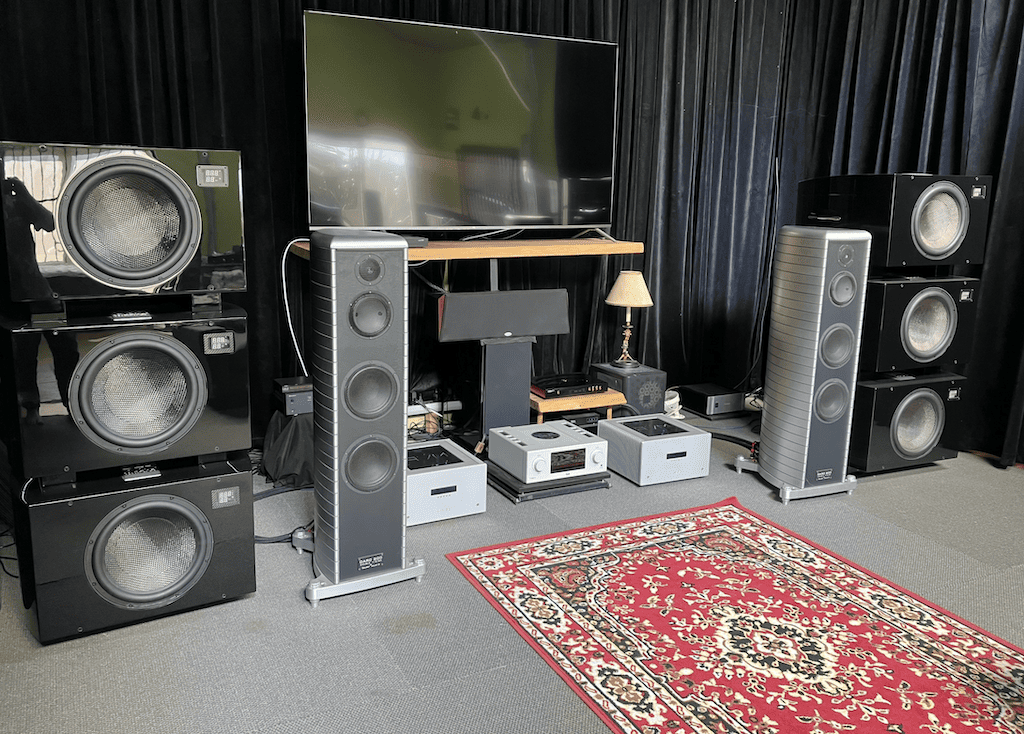
Alex Hastie has basically said “bollocks to all that nonsense” and done exactly what he wanted to do. The name of his high-end high-fidelity operation – Last Frontier Audio – says it all. Alex lives and operates in an obscure (and very beautiful) bush-clad spot in the Far North of New Zealand and the whole focus of his life and house is the hi-fi room.
Like all hi-fi experts/obsessives, Alex is a personality-plus kind of guy who knows his own mind and is tuned in to what turns him on. Having formerly lived his life between Christchurch and San Francisco, where he made his living running restaurants and a catering operation, he says that even as a young lad he was fascinated with stereo systems and that it’s a passion that has never dissipated.
Like me, Alex is an older chap (we’re both 64 as it happens, but please don’t start humming that song) and even though having a top-of-the-line audiophile system is but a pipe dream for me, I relate very strongly to Alex’s decision to focus his life on hi-fi.
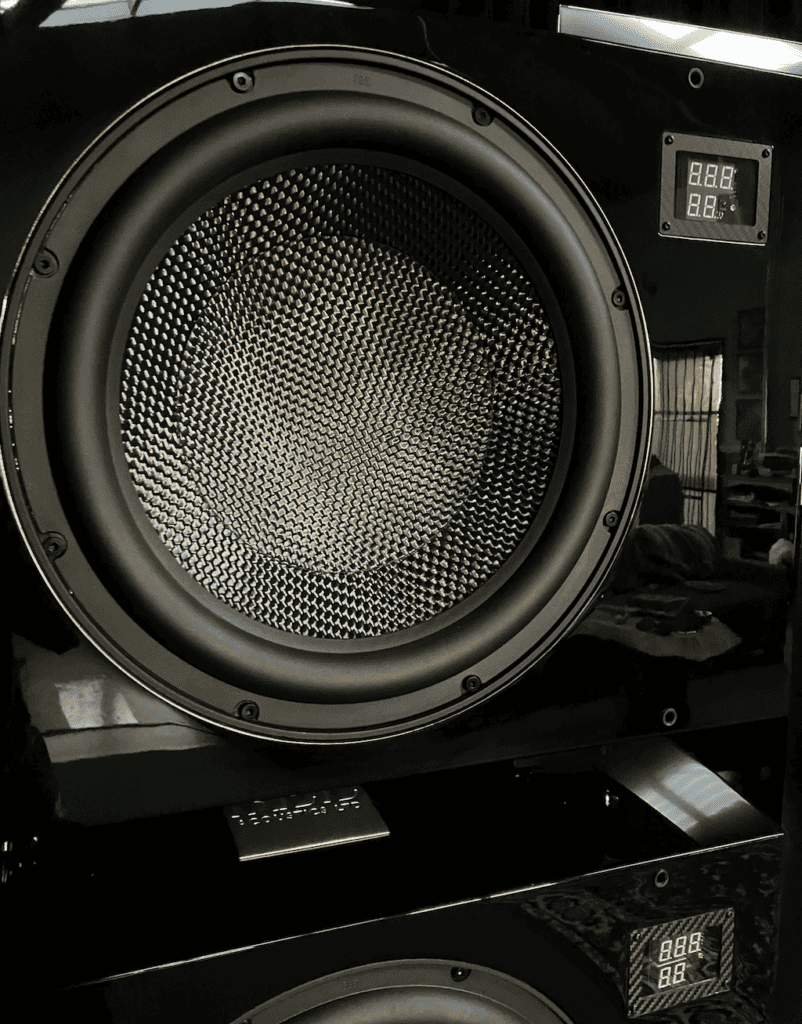
And what a system! As you can see in the pics I took when I visited Alex’s abode, the assembled audio componentry in this system makes it one of the very best home audio experiences anywhere in NZ. Probably the only system that impressed me as much was Paul Quilter’s (of PQ Imports) hi-fi room at Tamihere, part of a purpose-built straw-bale home with a dedicated cathedral-like room (sadly no more, and no, it didn’t burn down!)
Would you like to support our mission to bring intelligence, insight and great writing to entertainment journalism? Help to pay for the coffee that keeps our brains working and fingers typing just for you. Witchdoctor, entertainment for grownups. Riveting writing on music, tech, hi-fi, music, film, TV and other cool stuff. Your one-off (or monthly) $5 or $10 donation will support Witchdoctor.co.nz. and help us keep producing quality content. It’s really easy to donate, just click the ‘Become a supporter’ button below.
There’s a big difference between the two, however. Paul might disagree with my assumption, but to me, his former space was the perfect way to hear a record as close to the original source as possible. This is the conventional home hi-fi aspiration: for a system to accurately reflect the actual recording. Of course, this is next to impossible because there are just too many random factors at play. Everything from the way the recording is mastered to the cables used to the room acoustics subtly changes the sound. And of course, we can never actually travel to the studio the recording was made in and hear it being recorded to compare! Having said that, Paul’s system was as close to achieving sonic perfection in a (sort of!) home environment that I’ve ever heard.
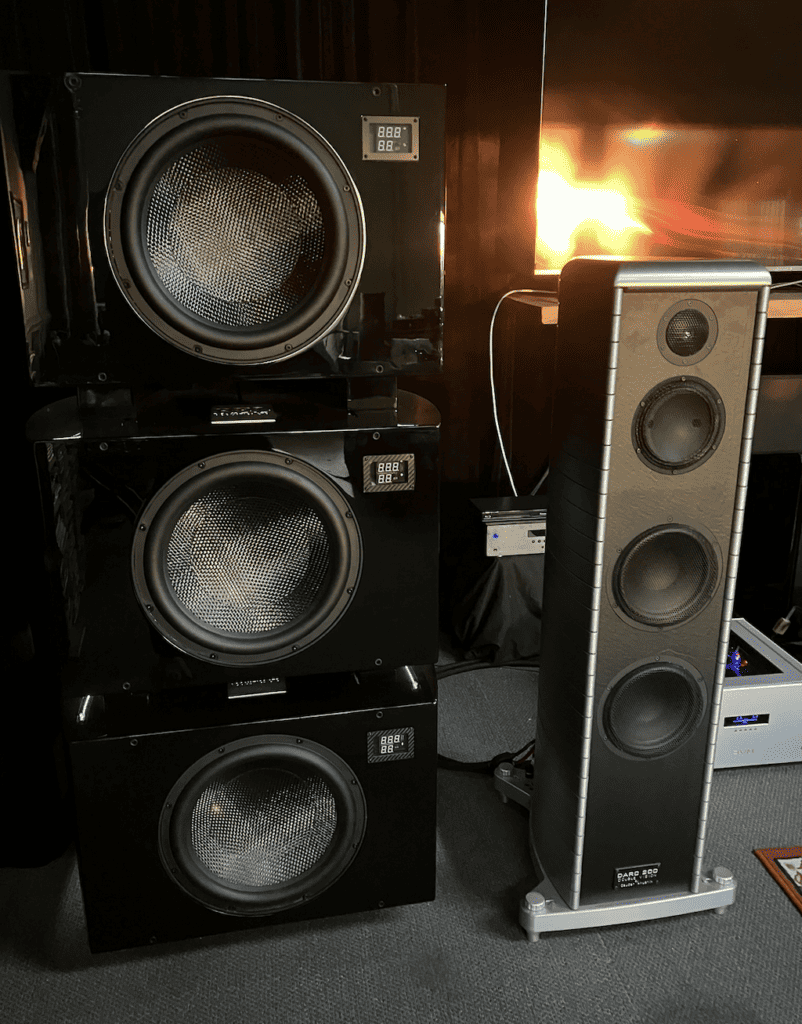
Alex’s requirements are slightly different, and his system reflects this. He’s a fan of live music and likes it loud. Unlike stereotypical hi-fi nuts, whose world seems to spin on groups like Dire Straits, The Eagles and Steely Dan, Alex is a big fan of the hi-octane electronics of German group Rammstein, and has travelled extensively to see them in concert. Another of his favourites is a group called Heilung, who are no wilting daisies themselves when it comes to making a big noise.
Consequently, Alex set out to create a system that would give something of the scale of a rock gig but at home. The room even looks like a small theatre. This makes for the best of both worlds: the excitement, volume and energy of a concert but without the often-dodgy sound quality and other random elements like drugged-up punters vomiting on your shoes or screaming in your ear. The only loss is something of the spontaneity of a concert, but the advantages to those of us who love great sound easily outweigh the disadvantages.
Despite living in a remote location, Alex’s internet speed is just fast enough to handle the hi-res streamed music that he predominantly plays through the system. A few years ago he decided it was time to jump into the world of streaming and leave behind most of those relics of a past golden era – LPs and CDs. To achieve this, he dug into a period of intensive research and built his own Last Frontier Music Server, which has ditched the old Intel chips for the latest AMD chips and processor, and also features (very important, this) a JCat XE USB card powered by Plixir BDC.
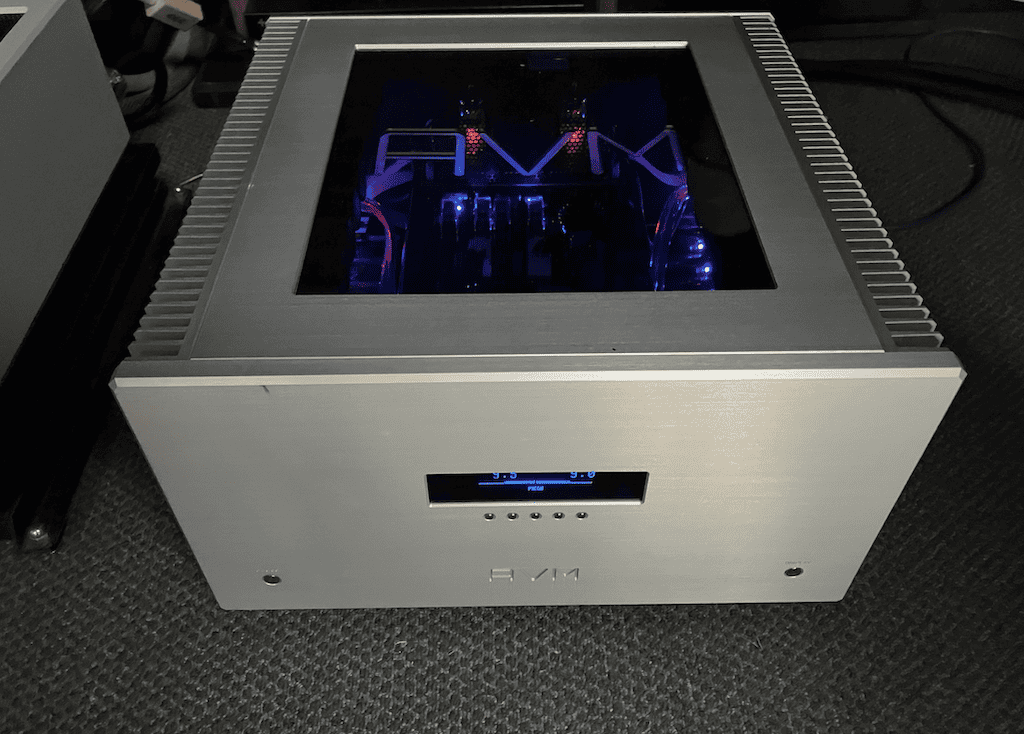
Also central to his hi-fi system is the combined and beautifully integrated woosome twosome of Roon and Qobuz. Described as a “connecting, streaming and music management software”, Roon not only improves the sound but also the experience of using digital files, integrating stored music libraries with streamed content. Compared to the individual apps for any of the streaming music platforms it’s a dream to use, making it super-easy to find what you want and coming up with often great suggestions for new things to listen to. Alex has a lifetime subscription to Roon, which ultimately saves a heap of money over the long haul. Qobuz is an excellent fit with Roon. The hi-res French streaming music outfit might have a slightly smaller number of available albums than the poor-sounding Spotify, but it’s gratifying to come across a company that takes high-quality music reproduction and curation seriously.
One of the conversations we have during our evening together is around my poor experience listening to classic rock through streaming services. I had recently listened to one of my favourite groups, Peter Green’s Fleetwood Mac, via Roon and Qobuz on my own humble system, and it sounded terrible. It turned out that I had selected a compilation that already sounded poor on CD, and streaming seemed to bring out its harsh and thin characteristics. I found a decent remaster while browsing at Alex’s and it sounded okay through his system, but one thing is clear: a lot of late 1960s multitrack rock records don’t translate especially well to hi-res digital reproduction. Recording studios were still fumbling around trying to figure out how to properly capture loud rock groups and it really wasn’t until the early ‘70s that rock records started sounding really great (The Beatles’ Abbey Road excepted).
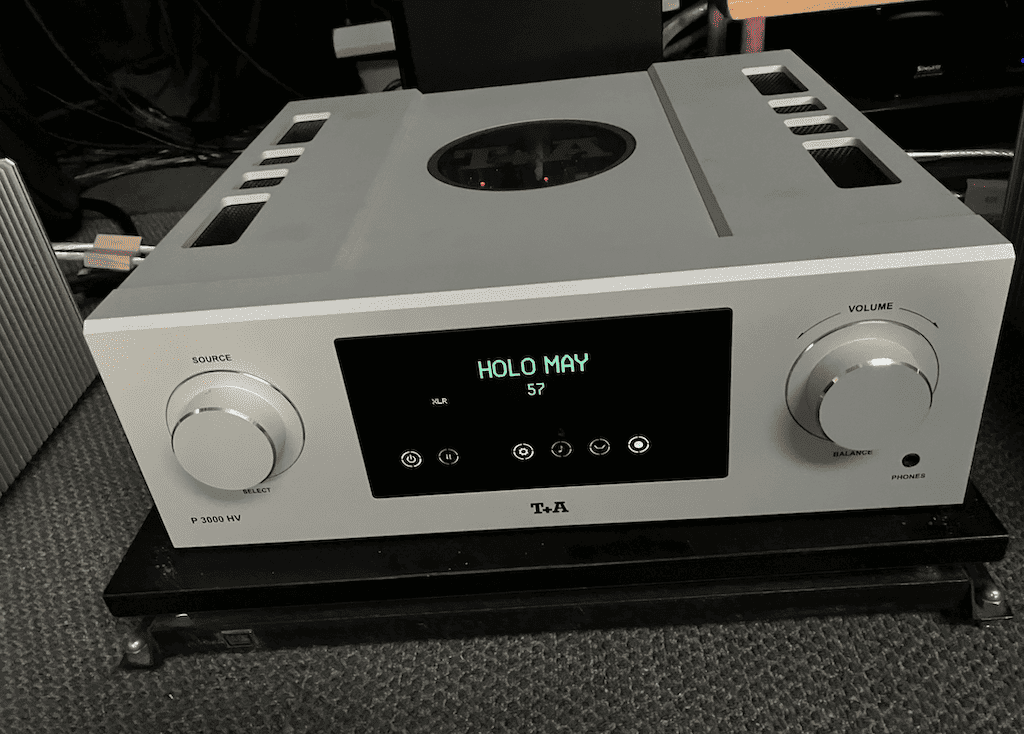
I had half expected Alex to do the older guy thing and start berating young people’s music and talk about how much greater music was in his day. Instead, he said that he hardly ever listens to “old music” now, and that life has become a voyage of discovery since he joined up with Qobuz. During the evening he played a selection of tracks he likes (none of which I can remember the names of), all of which were very contemporary and mostly electronic and tended to utilize the spatial abilities of hi-fidelity reproduction in a most gratifying way.
As for me, I pumped up the volume on a few old favourites and for at least some of the time, my jaw was practically on the floor. (Just as well Alex keeps a clean house). Spiritchaser by Dead Can Dance sounded just as stereophonically trippy and percussively dynamic as it should do and Polytown by David Torn, Mick Karn and Terry Bozzio was just insane. I love the way Bozzio’s octopus-like drums snap and crash and drive along like their own symphony while the late lamented Karn’s fretless bass performs the low-slung melodic duties, and the sound system propelled it along with such effortless grace and immense dynamics that it took my breath away.
And then there was the Zappa track. I had told Alex that on my own system, some of the complicated horn charts (not to mention the busy marimbas and other instruments) on Frank Zappa’s late ‘60s/early ‘70s work somehow failed to properly resolve, even when mastered at 192kHz. I played a track from one of my favourite Zappa albums, The Grand Wazoo, a recording featuring a strong horn section but also Aynsley Dunbar’s propulsive drums and some outlandish Zappa guitar. ‘Eat That Question’ combines all of those elements and wow, it sounded so good on this system that I could have easily settled down to a long Zappa session. Thankfully, I’m an empathetic kind of guy and stopped myself from torturing my host unnecessarily. It wasn’t just a case of hearing more detail (although there was that) but also of – once again – genuine scale and dynamics that brought it alive in a way I haven’t heard in the literally hundreds of times I’ve listened to the track.
But what about that six-pack of mega-subs, you ask? Why would anyone need six $15K premium REL 25s? The short answer is, “he doesn’t”, and Alex will probably end up making do with fewer subs in the long run for a very similar result. But one of the main takeaways from my experience with Alex’s system is that despite the size and number of bass bins, the bass actually wasn’t overwhelming. In fact, when REL agent Paul Quilter had tuned the subs to the rest of the system, they were perfectly integrated with the gorgeous $150K Gauder Akustik DARC 200 speakers. And that’s the trick. As Alex said, the Gauder Akustik’s on their own sound splendid and put out ample bass. The REL subs are there to seamlessly take that bass down really, really low, not add an ugly bass bubble to the sound. Indeed, if the subs hadn’t been tuned to the system, they could have overwhelmed everything else and ruined the exquisite sonics.
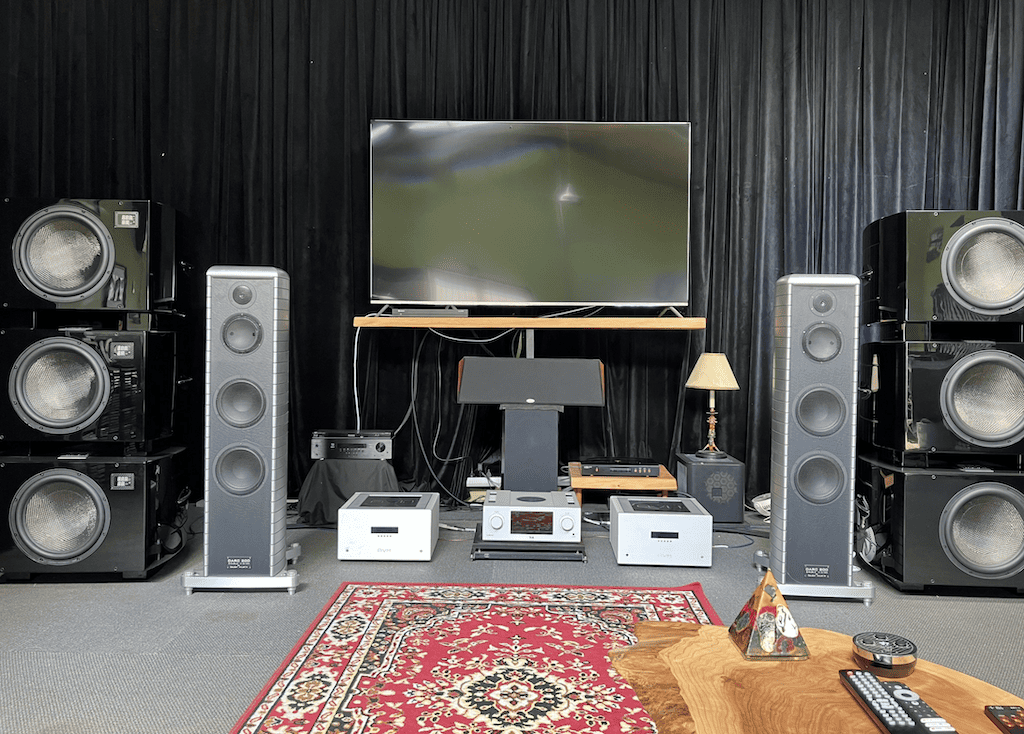
There’s a lot to “write home about” with this system but I’m going to try and keep it short, both for my sanity and my readers’ patience. While the REL subs provide the visual “wow” factor, it’s the Gauder Akustik speakers that are really the heart of the system. I’ve auditioned a couple of entry-level models in the German company’s range (see those reviews here) and they are indeed a fine speaker. So good in fact, that it’s hard to fathom why they don’t have a higher profile than they do. I guess the fact is that the brand simply doesn’t do “cheap” and with even standmount speakers coming in over $10K, they’re out of reach of many, and competing in a very, very crowded market.
But anyway, the Gauder Akustik DARC 200 are very handsome speakers and I’m sure you can, if you wish, read about them online. Also worthy of note, of course, are the two rather large AVM Ovation SA 8.3 bi-amped power amps and yet another German brand, the T+A HV 3000 preamp. It’s seldom just one brand that makes a system that works in perfect harmony, but Alex has, through trial and error (and a whole bunch of research) found a truly winning combination, with all the bottom end you could ever hope for, vast soundstage, extra texture where it’s required, and a perfectly transparent top end. Alex is living the dream because he had the gumption to reach out and go for a no-compromise system. Although it was a little disappointing to come back to my modest hi-fi, it’s great to know just how far you can go and the spectacular results you can get as a result.
Postscript notes: David Joplin, the clever chap who constructed Alex’s PC server, made a few comments about things I either didn’t know or forgot to include in the story above, and which I thought it worthwhile sharing with you here:
“The REL bass complements not just the lower frequencies but seems to affect the whole frequency range. There is an interesting impact when the REL is turned off and on. The difference is uncanny but there seems to be more presence across the whole frequency range, the bass is extended and the mid-range smoother.” I should note that PQ Imports man Paul Quilter has been riffing on this point for years: that REL subs give extra texture/magic to the whole sonic picture.
“The DARC 200 is a compact speaker with great room affinity. It easily outperforms speakers with much greater volume. The aluminium ribbing and speaker construction eliminates cabinet resonance. Tap the speaker and you get a dull thud. A key differential of Gauder Akustik is their unique crossover with a 64db plus separation of the drive units. English speaker crossovers spread the same frequency across multiple speakers giving a different sound.
“The music server is a custom-built AMD PC powered by a linear power supply configured with Roon Rock. The motherboard is configured to remove processor symmetrical multi-processing (ie, no threads) resulting in cleaner music processing and reduced CPU overheads.”
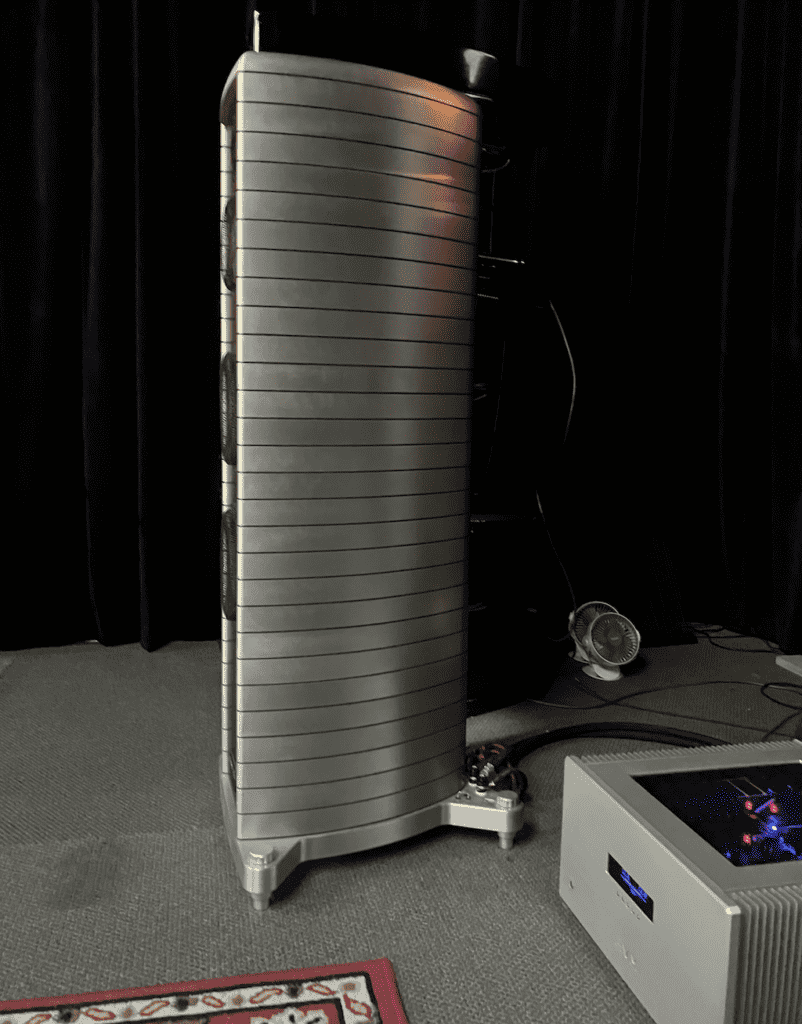
Gear:
Last Frontier Music server
Powered by linear Teradak
Latest AMD chips and processor
Music library 8 TB SSID
Streaming Roon/ Qobuz
JCat XE USB card powered by Plixir BDC
DAC
Halo May level 3
With Singxer Su 6 USB bridge.
Pre Amplifier
T + A HV 3000 with EQ module.
Power Amps
AVM Ovation SA 8.3 x 2 configured in Bi Amp horizontal mode.
Speakers
Gauder Akustik DARC 200 with diamond tweeters and double vision crossover.
REL 25 six Pack
+ Alex runs Last Frontier Audio, local agents for Gauder Akustik loudspeakers. He can be contacted on 021 025 50463 or ahhastie@gmail.com.
















